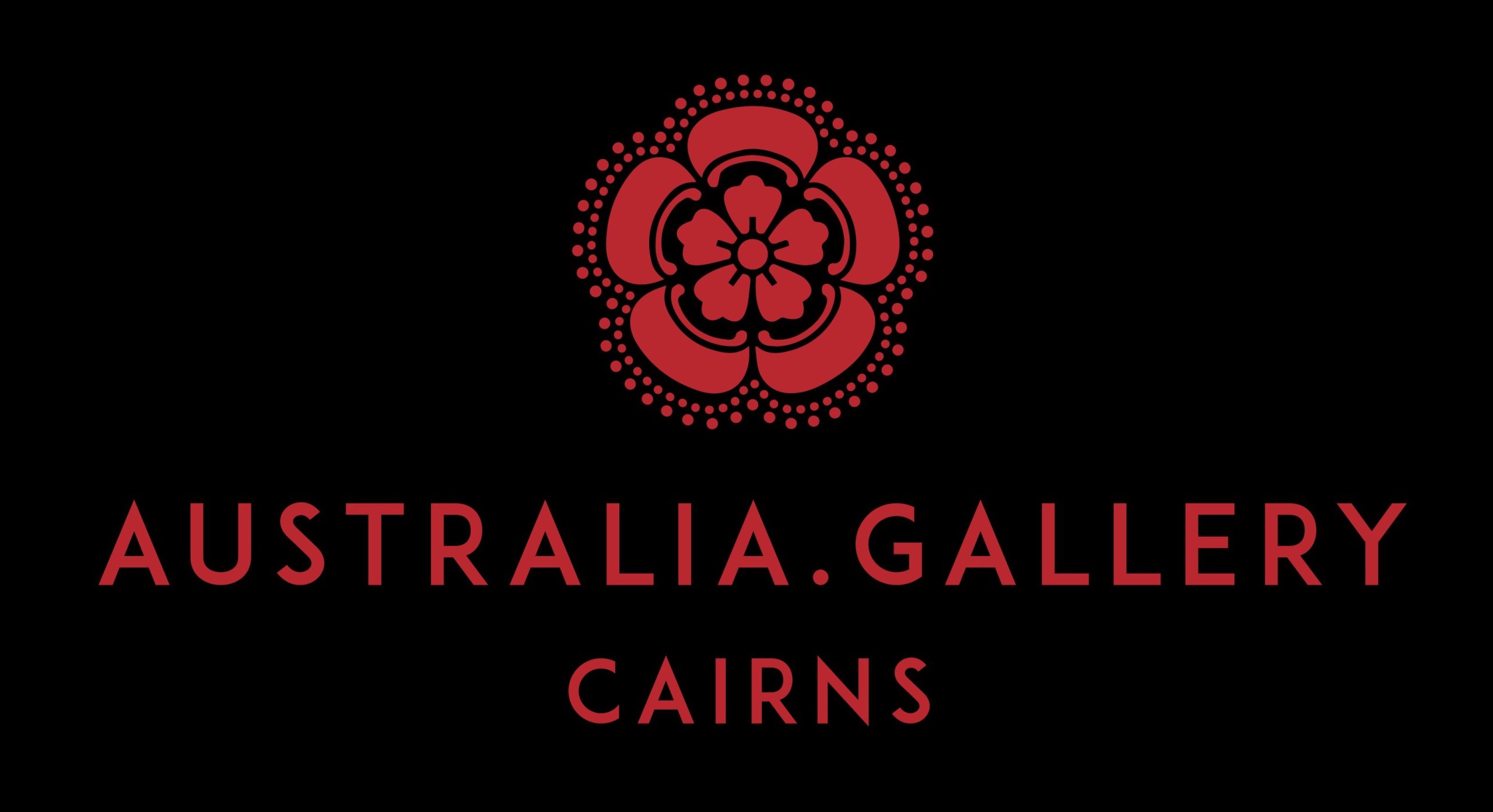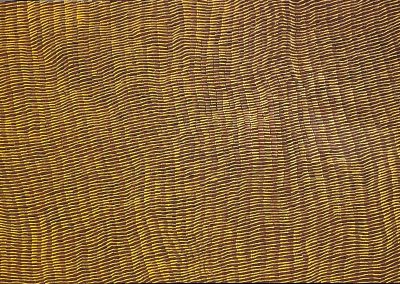Yukultji Napangati Tali Sandhills Painting. Australian Aboriginal Art
Enquire
145 cm x 94 cm
Title: Tali
Yukultji is the daughter of Nanu Nangala and Lanti Yukulti and has many siblings making up their nomadic tribe well known artists Warlimpirrnga, Thomas ,Wallala Tjapaltjarri . While many Pintupi people were forced off their land through colonization, Yukultji’s family managed to live out of reach from authorities.They were known as the “last tribe” and the Pintupi Nine. They lived in the bush by old ways of life, hunting, gathering and existing in complete isolation from the outside world. She grew up without knowing about places like Kiwirrkurra , or her relatives living there. She had never met anyone from outside their tribe. Her family lived a completely traditional Nomadic way of life on a diet of bush plants, kangaroo and goanna. Her father had lived for a short time at the in Balgo , but he had run away after getting into trouble for stealing food. It was his decision to stay in the desert, and kept his family far away from the towns. Napangati’s father died sometime around 1980. The family finally came into contact with outsiders in October 1984, and were settled at Kiwirrkurra. Emerging from the bush, they became known as the last of the desert nomads. The event was big news at the time, and the family became famously known as “the last nomads”.] Napangati was 14 years old and the youngest of the group.
After her family emerged they were introduced to a completely new lifestyle. Napangati experienced major Culture Shock when first coming out of the desert. She often found new things difficult to understand. In an interview once, she remembers, “I hopped into a car and crouched down, and I saw the trees move. I was frightened. I was scared. I jumped right off because the trees were racing around the place.”[ It was during this time that she first saw white people, started wearing clothing and began eating European food.
Yukultji married Charlie Ward Tjakamarra and together they had a daughter and a son. The passing of Charlie inspired her to become more involved with art
Yukultji Napangati was born at the sacred site Marrapinti, a significant women’s ceremonial site where, during ancestral times, a large group of women camped to perform ceremony before continuing their travels to the east. Yukultji grew up living a seminomadic lifestyle in the bush until 1984, when at the age of fourteen, she and her family group were sighted by settler Australians and reunited with Pintupi kin at the newly established community of Kiwirrkura. Reflecting on her childhood, Napangati has said:
“When I was young, I would play on the sand dune and when we saw the old people returning to camp we would go back and see what food they had brought with them. After we ate, we’d go to sleep. No blanket, we would sleep on the ground…Then we would go to another waterhole and make another camp.”
Napangati began painting for Papunya Tula Artists in 1996, as part of a growing cohort of groundbreaking Pintupi women, 25 years on from the founding of Papunya Tula Artists. Napangati’s singular approach to mark-making utilizes a repeated pattern of interconnected lines and dots that consume her canvases and generate the illusion of movement. This illusory shimmer inherent to Napangati’s work reflects the rippling tali (sand dunes) of her homelands, deep in the Gibson Desert north of Kiwirrkura, near the great salt lake Wilkinkarra (Lake Mackay), Western Australia.
Napangati uses acrylic paint rather than natural ochers throughout her work. Minimalist in palette and formally abstract, her works are informed by her matrilineal Tjukurrpa—ancestral knowledge, narratives, and histories—passed down from her mother and mother’s mother. Her approach involves intense, refined two-toned mark-making that colonizes the canvas, creating dotted, linear formations specifically related to her mother’s Country, Marrapinti. As is customary, she often paints this site alongside her sister and fellow Papunya Tula artist, Yalti Napangati.
Napangati’s work has been exhibited extensively both in Australia and internationally. Notable exhibitions include her solo exhibition, Yukultji Napangati (2019), Salon 94, New York, (USA); Fear of Property (2022), The Renaissance Society, University of Chicago (USA); the landmark exhibition Marking the Infinite: Contemporary Women Artists from Aboriginal Australia (2016–19), presented at Newcomb Art Museum, Tulane University, New Orleans; Patricia & Phillip Frost Art Museum, Florida International University, Miami; Nevada Museum of Art, Reno; The Phillips Collection, Washington DC (all USA); the Museum of Anthropology, University of British Columbia, Vancouver (Canada); and Desert Painters of Australia (2019–20), Gagosian, Hong Kong, (China), New York and Los Angeles (both USA).
In 2018, Napangati was awarded the esteemed Wynne Prize by the Art Gallery of New South Wales, Gadigal/Sydney (Australia). Her work is held in numerous private and public collections nationally and internationally, including the Harvard Art Museum, Cambridge (USA); Hood Museum of Art, Dartmouth College, Hanover (USA); Metropolitan Museum of Art, New York (USA); Milwaukee Art Museum, Wisconsin (USA); and Toledo Museum of Art, Ohio (USA).
Yukultji is the daughter of Nanu Nangala and Lanti Yukulti and has many siblings making up their nomadic tribe well known artists Warlimpirrnga, Thomas ,Wallala Tjapaltjarri . While many Pintupi people were forced off their land through colonization, Yukultji’s family managed to live out of reach from authorities.They were known as the “last tribe” and the Pintupi Nine. They lived in the bush by old ways of life, hunting, gathering and existing in complete isolation from the outside world. She grew up without knowing about places like Kiwirrkurra , or her relatives living there. She had never met anyone from outside their tribe. Her family lived a completely traditional Nomadic way of life on a diet of bush plants, kangaroo and goanna. Her father had lived for a short time at the in Balgo , but he had run away after getting into trouble for stealing food. It was his decision to stay in the desert, and kept his family far away from the towns. Napangati’s father died sometime around 1980. The family finally came into contact with outsiders in October 1984, and were settled at Kiwirrkurra. Emerging from the bush, they became known as the last of the desert nomads. The event was big news at the time, and the family became famously known as “the last nomads”.] Napangati was 14 years old and the youngest of the group.
After her family emerged they were introduced to a completely new lifestyle. Napangati experienced major Culture Shock when first coming out of the desert. She often found new things difficult to understand. In an interview once, she remembers, “I hopped into a car and crouched down, and I saw the trees move. I was frightened. I was scared. I jumped right off because the trees were racing around the place.”[ It was during this time that she first saw white people, started wearing clothing and began eating European food.
Yukultji married Charlie Ward Tjakamarra and together they had a daughter and a son. The passing of Charlie inspired her to become more involved with art
Yukultji’s paintings are shown in many public collections in Australia, but her work has also been shown in over 80 exhibtions in Australia and overseas.
In 2009 Napangati traveled to New York for a solo exhibition at Salon 94 in the Bowery which promoted monumental success for her career.
She was a finalist in the (NATSIAA awards), in 2006, 2009, 2010 and 2011.
In 2012, Napangati won the Alice Prize , an award for Australian artists in Alice Springs
In 2018, she won the Wynne pRIZE for landscape painting.
In 2018 Napangati’s work was included in the exhibition Marking the Infinite: Contemporary Women Artists from Aboriginal Australia at the Phillips Collection
In 2019, US rapper Jay – Z bought one of Napangati’s artworks, which was featured on an Instagram post by his wife Beyoncé in July 2021, attracting 3.5 million likes within a week.
https://www.smh.com.au/world/north-america/yukultji-napangati-s-shimmering-outback-images-shine-in-new-york-20190124-p50t9w.html



